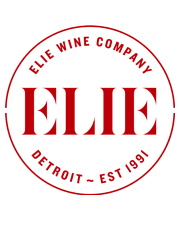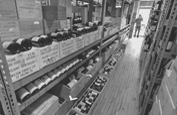Dispatches from the Land of Cabernet Franc
Join us this Saturday as we explore the diversity of the Middle Loire valley through several different bottles. Although adjacent, Saumur-Champigny and Chinon belong to two separate sub-regions; Anjou-Saumur and Touraine, respectively. Both regions are known for malleable limestone (tuffeau) that has been built into many a castle and cold underground cellar. Yet the soils are as varied as the expressions of Cabernet Franc that come from these areas with the potential to produce France’s most refreshing and elegant versions of this grape variety.
All prices based on the purchase of six or more bottles (mix and match).
Domaine Filliatreau: Saumur-Champigny
 Imagine yourself in a Paris bistro enjoying a whole roast chicken with a heap of pommes frites. The wine you might be drinking is one Paul Filliatreau’s Cabernet Franc wines from Saumur-Champigny. After taking over the family domaine in 1967, Paul soon began bottling and selling wine made at the estate — not the norm in an era of cooperatives. It didn’t take long for the light and fresh style of Paul’s wines to become a hit in Parisian bistros, which remain the main market for Filliatreau wines to this day.
Imagine yourself in a Paris bistro enjoying a whole roast chicken with a heap of pommes frites. The wine you might be drinking is one Paul Filliatreau’s Cabernet Franc wines from Saumur-Champigny. After taking over the family domaine in 1967, Paul soon began bottling and selling wine made at the estate — not the norm in an era of cooperatives. It didn’t take long for the light and fresh style of Paul’s wines to become a hit in Parisian bistros, which remain the main market for Filliatreau wines to this day.
The present era of Filliatreau sees Paul’s son, Frédrik, as the fourth generation to run the estate, now a total of almost 100 acres of vines across dozens of varied parcels. Their approach to farming adheres to a philosophy of sustainability and the domaine is undergoing conversion to organic cultivation with some biodynamic methods. Massale selection is used for all new plantings. After harvest, the fruit is hand-sorted, destemmed, and fermented with natural yeasts in temperature-controlled, stainless steel tanks. The wines are moved by gravity and aged almost exclusively in steel.
 ~$18 “La Grande Vignolle” is 100% Cabernet Franc. The 14 acre lieu-dit of Grande Vignolle sits on a rich limestone plateau above the Loire River. The vines are 35 to 40 years old and lie at the northern limit of the Saumur-Champigny appellation. A juicy and fleshy wine for near-term drinking.
~$18 “La Grande Vignolle” is 100% Cabernet Franc. The 14 acre lieu-dit of Grande Vignolle sits on a rich limestone plateau above the Loire River. The vines are 35 to 40 years old and lie at the northern limit of the Saumur-Champigny appellation. A juicy and fleshy wine for near-term drinking.
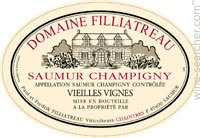 ~$24 “Vielles Vignes” is 100% Cabernet Franc from the estate’s most significant vines. The fruit is harvested from vines that are 50 to 90 years old growing out of clay-calcerous soils around the village of Chaintre (just about midway between the towns of Saumur and Champigny). A powerful and lengthy expression of Cabernet Franc capable of developing in a proper cellar for a decade or more.
~$24 “Vielles Vignes” is 100% Cabernet Franc from the estate’s most significant vines. The fruit is harvested from vines that are 50 to 90 years old growing out of clay-calcerous soils around the village of Chaintre (just about midway between the towns of Saumur and Champigny). A powerful and lengthy expression of Cabernet Franc capable of developing in a proper cellar for a decade or more.
Bernard Baudry: Chinon
 Bernard Baudry is easily one of Chinon’s best producers. Born into a winemaking family, Bernard studied oenology in Beaune and began his professional life as a vine-tending consultant at the Tours laboratory. In 1975 he decided to start his own estate with five acres of vines in the village of Cravant-les-Coteaux. Today the estate is 79 acres and Bernard’s son, Matthieu, works with his father to continue producing the consistent, high-quality wines for which the domaine is celebrated.
Bernard Baudry is easily one of Chinon’s best producers. Born into a winemaking family, Bernard studied oenology in Beaune and began his professional life as a vine-tending consultant at the Tours laboratory. In 1975 he decided to start his own estate with five acres of vines in the village of Cravant-les-Coteaux. Today the estate is 79 acres and Bernard’s son, Matthieu, works with his father to continue producing the consistent, high-quality wines for which the domaine is celebrated.
The Baudry vineyards have always been cultivated according to environmentally friendly methods and have been organically farmed since 2006. To rebalance the organic matter in the soils they maintain their own compost based on cow manure and straw. Yields are controlled by partial disbudding of the vines but the ultimate goal is to find the right balance based on vintage conditions where the vines naturally restrict their own yields. Harvest is done 100% by hand and post-harvest all fruit is de-stemmed and placed into gravity-fed vats where fermentation takes place with indigenous yeasts.
 ~$31 “Le Clos Guillot” is 100% Cabernet Franc produced from a plot of a little less than 10 acres in size that was planted between 1993 and 2000. The parcel is situated on a south-southwest exposed slope with clay soils on top of the hill and yellow tuffeau lower down the grade and results in a wine that is robust, flinty, and full of tension. The Baudrys are traditionalists and it shows in this classic Chinon.
~$31 “Le Clos Guillot” is 100% Cabernet Franc produced from a plot of a little less than 10 acres in size that was planted between 1993 and 2000. The parcel is situated on a south-southwest exposed slope with clay soils on top of the hill and yellow tuffeau lower down the grade and results in a wine that is robust, flinty, and full of tension. The Baudrys are traditionalists and it shows in this classic Chinon.
- - -
Posted on 2019.08.08 in France, Saturday Sips Wines, Loire | Read more...
The Champagne Society August 2019 Selection: Champagne Tarlant
Champagne Tarlant “Zero” Brut Nature
Two Half Bottles
Price for The Champagne Society members: $64
The Tarlant family has tended vines in the Vallée de la Marne since 1687. They began producing their own wine in the 1870s. Such a long and rich history has allowed Benoît Tarlant, the latest family member to head the estate, to continue their reign as one of the region’s most distinguished growers. 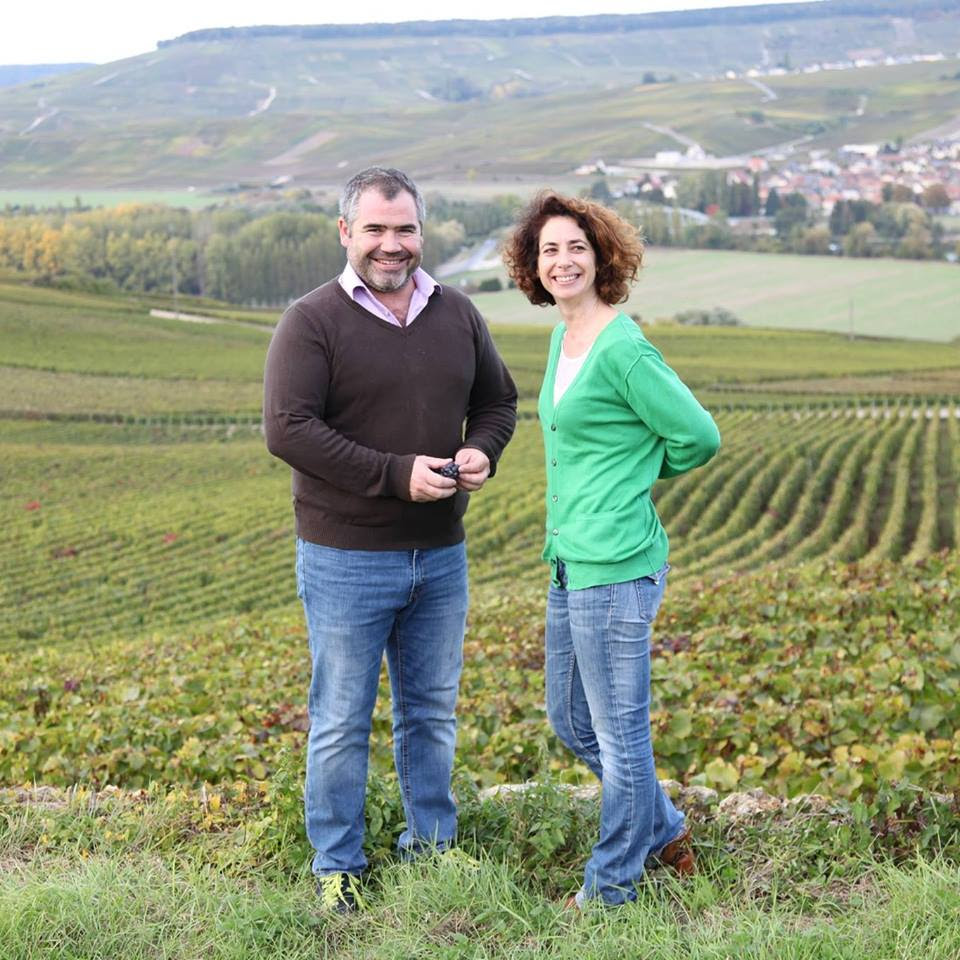 Benoît’s sister, Mélanie, works the business and marketing side of the operation.
Benoît’s sister, Mélanie, works the business and marketing side of the operation.
Benoît’s Ultimate goal is to make zero-dosage Champagne by means of harvesting his fruit when it reaches its “prettiest” maturity — full of flavor with the acidity in balance. But he is not an absolutist. He will adjust his philosophy when the wines call for it, although it is rare for him to produce a wine that receives more than 6g/L dosage (just a hair over Extra Brut).
Based in the village of Oeuilly, the estate totals 34 acres spread across 57 parcels, each vinified separately. The vines average around 30 years old. Benoit embraces the diversity of his many plots but finds it a challenge to cultivate so many distinct sites using one strict technique. Subsequently, he employs a range of methods depending on the site.  Some parcels are managed with biodynamic techniques, some organic, and some with Benoît’s form of “herbal therapy,” where various beneficial herbs are planted among the vines.
Some parcels are managed with biodynamic techniques, some organic, and some with Benoît’s form of “herbal therapy,” where various beneficial herbs are planted among the vines.
“Zero” is one of Champagne’s best Brut Nature (zero dosage) wines. There are decades of effort in perfecting the cuvée as Benoît’s father, Georges, has been making it since the early 1980s, long before it became trendy. The blend is roughly equal proportions of Pinot Noir, Chardonnay, and Pinot Meunier. Ripe fruit, several vintages of reserve wine, and long aging on the lees combine to produce a wine of beautiful depth. Layers of ripe yellow plum, peach, and citrus precede a honey-toasted richness.
- - -
Posted on 2019.08.01 in France, The Champagne Society, Champagne | Read more...
Thrilling New High-altitude Biodynamic Wines from Pepe Raventós
You most likely already know Pepe Raventós as the head of Raventós i Blanc — a leading producer of Spanish sparkling wines that have become one of our most popular selections at the shop. Raventós i Blanc is one of the few producers of Spanish sparkling wine that grows, tends, and harvests their grapes from their own property, ferments and vinifies their wines, and then sells them under their label. To borrow a phrase from Champagne, one can truly consider them a Récoltant Manipulant (Grower Producer).
Can Sumoi is a new project from Pepe Raventós and Francesc Escala to create vibrant wines from the mountains of the Baix Penedès in the Catalunya region of northeastern Spain. A farm dating back to 1645, Can Sumoi is located between the towns of Sant Jaume dels Domenys and Pla de Manlleu in the limestone mountain range of Massís del Montmell, where the vineyards reach heights of 1,800 feet above sea level. The estate has close to 1,000 acres of land but only about 50 acres are still planted to vine. The remainder is a forest of holm oak and white pine. You can still see the old dry-stone walls that were built years ago to terrace the slopes for cultivation of grapevines. It is a land very much influenced by the mountains and the sea. On a clear day you can see as far as the wetlands of the Ebro Delta to the southwest and the Island of Mallorca to the southeast.

When Pepe discovered the declining property of Can Sumoi, he immediately saw its potential to expand his work with biodynamic cultivation, and natural vinification (no additives are used in the process — including sulfites), to make still wines in a way that respects the environment and expresses the place they are from. He enlisted his childhood friend, Francesc Escala, to help begin the recovery of this once proud land.
The vineyards are mainly planted with the varieties Sumoll, Parellada, and Xarel-lo, all native to the region. The vines are trained in “gobelet” style, an ancient method that involves no wires or other system of support, and results in a goblet-shaped growth that helps to shade the fruit from the sun (this style is often referred to as a bush vine). The fruit is hand-harvested, which is a necessity with vines trained in this style. Fermentation is accomplished with indigenous yeasts in stainless steel vats.
These 2018 vintage wines from Can Sumoi share a freshness that is ideal for summer drinking.
All prices based on the purchase of six or more bottles (mix and match).
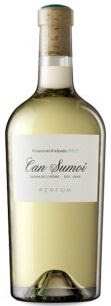 ~$21 Can Sumoi “Perfum” (Penedès 2018) White
~$21 Can Sumoi “Perfum” (Penedès 2018) White
True to its name, the wine exudes a heady mix of aromatics, primarily floral notes of jasmine and rose, although there is an abundance of orchard fruit as well. A sip leads with citrus that turns to soft, ripe apples on the midpalate. All that fruit rides a wave of juicy acidity all the way to the finish. The wine is a blend of 50% Moscatel, 30% Macabeo, and 20% Parellada. Although vinified completely dry, the Moscatel (Muscat) variety contributes much of its aromatic character to this wine. Bottled without additives or filtering.
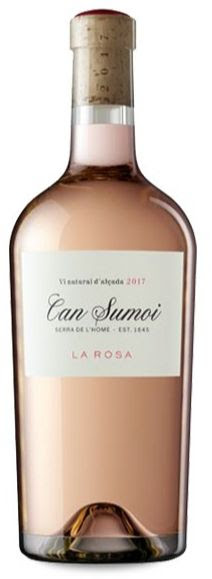 ~$23 Can Sumoi “La Rosa” (Penedès 2018) Rosé
~$23 Can Sumoi “La Rosa” (Penedès 2018) Rosé
Aromas of strawberries and basil waft from a glass. A sip is light and juicy on the palate and builds up to a mouthwatering climax of kiwi and redcurrant flavors. The rosé is produced from a blend of 50% Sumoll, 30% Parellada, and 20% Xarel-lo. Providing the pink is the grape Sumoll, a black-skinned variety native to the Penedès region. Sumoll goes by a number of different names in Catalan dialects, one of them being Sumoi, which possibly explains the name of the estate. Bottled without additives or filtering.
 ~$24 Can Sumoi “Xarel-lo” (Penedès 2018) White
~$24 Can Sumoi “Xarel-lo” (Penedès 2018) White
Perhaps the most elegant of the 2018 Can Sumoi. Crunchy apples, herbs, and minerals greet your nose prior to a sip of rich fruit built on a solid structural foundation. Produced from 100% Xarel·lo, a grape indigenous to Penedès that most sparkling wine drinkers will recognize as the principal variety that makes up Cava. After fermentation the wine sees a twice-weekly batonnage for three months before bottling without additives or filtering.
- - -
Posted on in Saturday Sips Wines, Spain DO, Penedes | Read more...
Pure Riesling and Pinot Noir from a Rising Star in Alsace
The winemaking region of Alsace — located in far eastern France, on the border of southern Germany — is perhaps the most geologically complex in all of France. 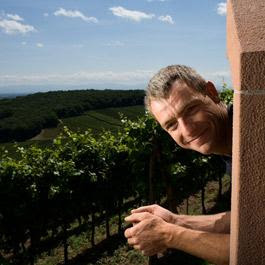 Much like Burgundy, the vineyards of Alsace lie on the western side of an escarpment that holds a mosaic of soil types and microclimates. A range of east-facing hillsides, sunny days, and protection from moisture by the Vosges Mountains make for an ideal environment to grow vines. Unlike Burgundy, the wines of Alsace are known more by grape variety than vineyard name, making it slightly more difficult to presume quality based on a label alone.
Much like Burgundy, the vineyards of Alsace lie on the western side of an escarpment that holds a mosaic of soil types and microclimates. A range of east-facing hillsides, sunny days, and protection from moisture by the Vosges Mountains make for an ideal environment to grow vines. Unlike Burgundy, the wines of Alsace are known more by grape variety than vineyard name, making it slightly more difficult to presume quality based on a label alone.
 Third-generation winemaker Félix Meyer’s Domaine Meyer-Fonné has been one of the top performers in contemporary Alsace. The winery and family home are based in the village of Katzenthal, known for its distinctive granite soils, situated just east of the city of Colmar about 15 miles from the border. The estate boasts 34 acres of vines in a mosaic of parcels (including five Grands Crus). The majority of their holdings are located on hillsides and planted to the noble varieties, producing wines of great energy and depth.
Third-generation winemaker Félix Meyer’s Domaine Meyer-Fonné has been one of the top performers in contemporary Alsace. The winery and family home are based in the village of Katzenthal, known for its distinctive granite soils, situated just east of the city of Colmar about 15 miles from the border. The estate boasts 34 acres of vines in a mosaic of parcels (including five Grands Crus). The majority of their holdings are located on hillsides and planted to the noble varieties, producing wines of great energy and depth.
The main focus at Domaine Meyer-Fonné is raising fruit of the highest quality. Cultivation is practicing organic as no synthetic fertilizers, herbicides, or pesticides are used. Winemaking is traditional with fermentation taking place through native yeasts. The wines are kept on the lees until May (Alsace AOC) or September (single vineyards) before bottling. All of Félix Meyer’s wines are characterized by heady aromatics and seductive textures attached to a frame of mineral tension.
All prices are based on the purchase of six or more bottles (mix and match).
![]() $27 “Vignoble de Katzenthal” Riesling (Vin d’Alsace 2017)
$27 “Vignoble de Katzenthal” Riesling (Vin d’Alsace 2017)
100% Riesling from a two acre vineyard of granite with mica and calcareous marl planted in 1985 and 2009. This cuvée also includes some fruit from declassified Grand Cru and lieux-dit sites. With a lovely bouquet of orchard fruits, chalky lemon, flowers, and wet stones, this is no ordinary or “frooty” Riesling. A sip is dry yet filled with crisp, ripe fruit balanced by a long and nervy finish. It is a classic Alsace Riesling worth stocking in your cellar for when the occasion calls.
![]() ~$40 “Altenbourg” Pinot Noir (Vin d’Alsace 2017)
~$40 “Altenbourg” Pinot Noir (Vin d’Alsace 2017)
100% Pinot Noir planted in 1996 in a 1.7 acre plot of marly limestone. This cuvée was first introduced to the Meyer-Fonné lineup in 2015. The wine ages in neutral oak for 15 months and then three months in tank before bottling. Fans of Pinot Noir from the Jura region will find elements in this wine that are both familiar and surprising. Cherry and herb aromas dominate the nose while a sip is sleek and racy. With fine tannins and a lengthy mineral finish, this an ideal summer red.
![]() ~$40 “Wineck-Schlossberg” Riesling (Alsace Grand Cru 2016)
~$40 “Wineck-Schlossberg” Riesling (Alsace Grand Cru 2016)
100% Riesling from 2.4 acres planted in 1958 and 2010. The Wineck-Schlossberg Grand Cru has a south-facing exposure rising above the village of Katzenthal and is characterized by a crumbly binary mica granite known as “de Turckheim.” A pure and delicate nose exudes spicy and mineral notes intermixed with ripe citrus. Feminine and ethereal on the palate, drink it now by candlelight, or throw a few in the cellar for future romantic evenings that call for a gorgeous bottle of white.
![]() $45 “Schoenenbourg” Riesling (Alsace Grand Cru 2017)
$45 “Schoenenbourg” Riesling (Alsace Grand Cru 2017)
100% Riesling planted in 1995 from a tiny plot around a third of an acre in size. The “Schoenenbourg” Grand Cru is the jewel of the charming, medieval village of Riquewihr. Its south-facing slope is established on unique “Keuper” soils of green-colored marl. With a voluminous palate, and a nose stacked with flowers and spice, this is a wine worth laying down for a few years or opening for a special meal.
- - -
Posted on 2019.07.25 in France, Saturday Sips Wines, Alsace | Read more...
Taste the Abruzzo Rainbow — New Vintage Wines from Cristiana Tiberio
Just in time for a withering heat wave here in Detroit, we’ve received a new shipment of wines from one of our favorite Italian producers. Cristiana Tiberio is based in the Cugnoli area of Pescarese (one of the four winemaking zones of Abruzzo). Her wines are characterized by a balanced freshness made possible by mild sea breezes drifting in from the Adriatic and the cool air currents flowing down the slopes of the Majella and Gran Sasso mountains.
 It’s thrilling to watch Cristiana’s star rising so fast. She has only been fully responsible for the winemaking at her family’s 74 acre estate since 2011. Yet she is already mentioned among the top producers of the region, consistently being awarded the coveted “Tre Bicchieri” (Three Glasses) by Gambero Rosso, the world’s leading authority on Italian wine. Her training in chemistry, along with stints in Champagne and Australia, backed by repeated visits to the Mosel and Chablis, inform her work in the cellar. And if you happen to follow her on Instagram, you would see that she is regularly educating her palate by drinking some of the world’s most significant wines.
It’s thrilling to watch Cristiana’s star rising so fast. She has only been fully responsible for the winemaking at her family’s 74 acre estate since 2011. Yet she is already mentioned among the top producers of the region, consistently being awarded the coveted “Tre Bicchieri” (Three Glasses) by Gambero Rosso, the world’s leading authority on Italian wine. Her training in chemistry, along with stints in Champagne and Australia, backed by repeated visits to the Mosel and Chablis, inform her work in the cellar. And if you happen to follow her on Instagram, you would see that she is regularly educating her palate by drinking some of the world’s most significant wines.
Abruzzo’s sunny hills, limestone soils, and aforementioned sea and mountain air currents, are more than capable of producing outstanding wines. Unfortunately, the reality is that too often many farmers find it convenient to join cooperatives and force production well beyond the limits of quality. A new generation of grower/producers in the region aims to show the world what’s possible when the focus is on creating wines that speak of place.
Indeed, the primary goal of the estate is to produce wines that clearly express the characteristics of the land they come from and the specific varieties that have adapted there. In Cristiana’s words: “One of the most important things for me in being a vigneron and making wines is to work just with massal selections. What is so unique in my wines are my biotypes, because they are the historical and authentic clones for each variety that I saved and propagated in order to express and respect the original flavors and aromas. These biotypes are unique and belong just to me, so they today represent the identity of my wines.”
A key figure in maintaining the authenticity of the vines is Cristiana’s brother, Antonio. As the estate’s viticulturalist, he is responsible for tending the vines. Together, the two are producing some of the most exciting Abruzzo wines available.
All prices are based on the purchase of six or more bottles (mix and match).

~$21 Montepulciano d’Abruzzo (DOP 2016) SOLD OUT
Cristiana and Antonio seek to express freshness of fruit in this wine made from over 50-year-old Montepulciano vines grown in clay-calcareous soil. With intense aromas of cherry fruit, violets, flint, and a snappy finish, this is a red wine that won’t become ponderous in the heat of summer. The 2016 season was cool and moist, exactly as Cristiana likes it to produce fruit with ideal ripeness. Subsequently, the 2016 Montepulciano d’Abruzzo is vibrant, refined, and elegant. Its silky tannins play alongside loads of fruit.

~$21 Cerasuolo d’Abruzzo (DOP 2018) SOLD OUT
Cerasuolo d’Abruzzo isn’t exactly a rosato. It is an official denomination and appellation to cover the cherry-red (Cerasuolo roughly translated means cherry-like), brightly flavored wines of Abruzzo made from the free-run juice of the Montepulciano grape with a short maceration prior to fermentation apart from the grape skins. Tiberio’s Cerasuolo d’Abruzzo is fleshy, with aromatics of flowers and citrus peel, and flavors of wild strawberries, cranberries, pomegranate, and rhubarb. 2018 was another cool and moist vintage. The Montepulciano grapes were harvested ripe but while the skins were still crunchy, producing a classic, juicy Cerasuolo d’Abruzzo.

~$22 “Pecorino” (Colline Pescaresi IGP 2017) SOLD OUT
Despite its name, there is no direct link between the Pecorino grape and Pecorino cheese. According to local legend, Pecorino gets its name from the sheep (pecora) that would snack on the grapes in the vineyards. The variety was thought to be extinct until it was found growing wild just north of Abruzzo in Marche and began a revival in the 1980s. Tiberio’s seven acres of Pecorino vines are planted on 20 foot deep limestone soils over clay and compacted sand and are some of the oldest in the region. The vines are naturally low yielding with a high total acidity so while production is low, the wines show a thrilling combination of rich texture and energy, green grass, flowers, salt, stone, and sunshine. The 2017 season was the hottest and driest of the past 50 years. The Pecorino yield was extremely low and produced wines that are exceptionally rich and concentrated. In this unique vintage, the traditional botanical flavors of Pecorino are expressed more toward thyme and lemon curd while the wine maintains its salinity.

~$22 Trebbiano d’Abruzzo (DOP 2016) SOLD OUT
Tiberio’s Trebbiano Abruzzese vines are especially noteworthy, not only because they are among the oldest in Abruzzo, but also because true Trebbiano Abruzzese is rare. Much of Abruzzo’s vineyards are actually planted to Bombino Bianco, Mostosa, and Trebbiano Toscano which were until very recently routinely confused with Trebbiano Abruzzese. While the four share similar features, they are distinct varieties. Trebbiano Abruzzese is the most noble of the four, producing wines that, while delicate and light-bodied, have greater depth and complexity. Lively and elegant, the 2016 shows exceptional balance with flavors of citrus and apricot, and notes of spicy white pepper. A couple of years from its release now, it is beginning to develop a touch of hazelnut that is typical of the variety.
- - -
Posted on 2019.07.18 in Saturday Sips Wines, Abruzzo, Italy | Read more...
Featured Wines
- Notebook: A’Boudt Town
- Saturday Sips Wines
- Saturday Sips Review Club
- The Champagne Society
- Wine-Aid Packages
Wine Regions
Grape Varieties
Aglianico, Albarín Blanco, Albillo, Aleatico, Alicante Bouschet, Aligote, Altesse, Arcos, Aubun, Auxerrois, Beaune, Bonarda, Cabernet Franc, Cabernet Sauvignon, Caino, Caladoc, Carignan, Chablis, Chardonnay, Chasselas, Chenin Blanc, Cinsault, Cortese, Corvina, Corvinone, Cot, Dolcetto, Ferrol, Fiano, folle Blanche, Frappato, Friulano, Fumin, Gamay, Garganega, Garnacha, Garnacha Tintorera, Godello, Grenache, Grenache Blanc, Grolleau, Jacquère, Lambrusco, Lladoner Pelut, Macabou, Maconnais, Malbec, Malvasia, Malvasia Nera, manseng, Marcelan, Melon de Bourgogne, Mencía, Merlot, Mondeuse, Montepulciano, Montònega, Morescola, Morescono, Mourv, Mourvèdre, Muscadelle, Nebbiolo, Nero d'Avola, Niellucciu, Palomino, Pecorino, Pedro Ximénez, Persan, Petit Verdot, Pinot Auxerrois, Pouilly Fuisse, Pouilly Loche, Poulsard, Prieto Picudo, Riesling, Rondinella, Rose, Rousanne, Roussanne, Sagrantino, Sangiovese, Sauvignon, Sauvignon Blanc, Savignin, Sciacarellu, Serine, Souson, Sylvaner, Syrah, Tannat, Teroldego, Timorasso, Trebbiano, Treixadura, trepat, Trousseau, vaccarèse, Viognier, ViuraWines & Events by Date
- September 2025
- August 2025
- July 2025
- June 2025
- May 2025
- April 2025
- March 2025
- February 2025
- January 2025
- December 2024
- November 2024
- October 2024
- September 2024
- August 2024
- July 2024
- June 2024
- May 2024
- April 2024
- March 2024
- February 2024
- January 2024
- December 2023
- November 2023
- October 2023
- September 2023
- August 2023
- July 2023
- June 2023
- May 2023
- April 2023
- March 2023
- February 2023
- January 2023
- December 2022
- November 2022
- October 2022
- September 2022
- August 2022
- July 2022
- June 2022
- May 2022
- April 2022
- March 2022
- February 2022
- January 2022
- December 2021
- November 2021
- October 2021
- September 2021
- August 2021
- July 2021
- June 2021
- May 2021
- April 2021
- March 2021
- February 2021
- January 2021
- December 2020
- November 2020
- October 2020
- September 2020
- August 2020
- July 2020
- June 2020
- May 2020
- April 2020
- March 2020
- February 2020
- January 2020
- December 2019
- November 2019
- October 2019
- September 2019
- August 2019
- July 2019
- June 2019
- May 2019
- April 2019
- March 2019
- February 2019
- January 2019
- December 2018
- November 2018
- October 2018
- September 2018
- August 2018
- July 2018
- June 2018
- May 2018
- April 2018
- March 2018
- February 2018
- January 2018
- December 2017
- November 2017
- October 2017
- September 2017
- August 2017
- July 2017
- June 2017
- May 2017
- April 2017
- March 2017
- February 2017
- January 2017
- December 2016
- November 2016
- October 2016
- September 2016
- August 2016
- July 2016
- June 2016
- May 2016
- April 2016
- March 2016
- February 2016
- January 2016
- December 2015
- November 2015
- October 2015
- September 2015
- August 2015
- July 2015
- June 2015
- May 2015
- April 2015
- March 2015
- February 2015
- January 2015
- December 2014
- November 2014
- October 2014
- September 2014
- August 2014
- July 2014
- June 2014
- April 2014
- March 2014
- February 2014
- January 2014
- December 2013
- November 2013
- October 2013
- September 2013
- August 2013
- July 2013
- June 2013
- May 2013
- April 2013
- March 2013
- February 2013
- January 2013
- December 2012
- November 2012
- October 2012

